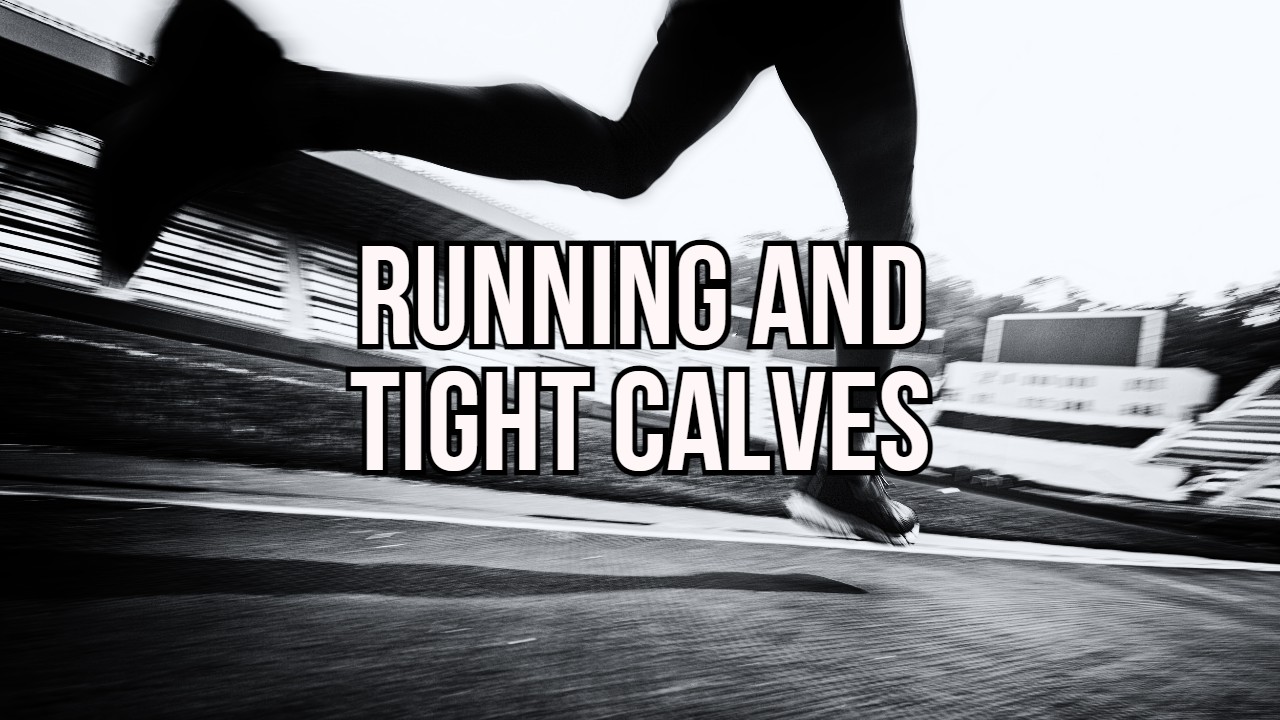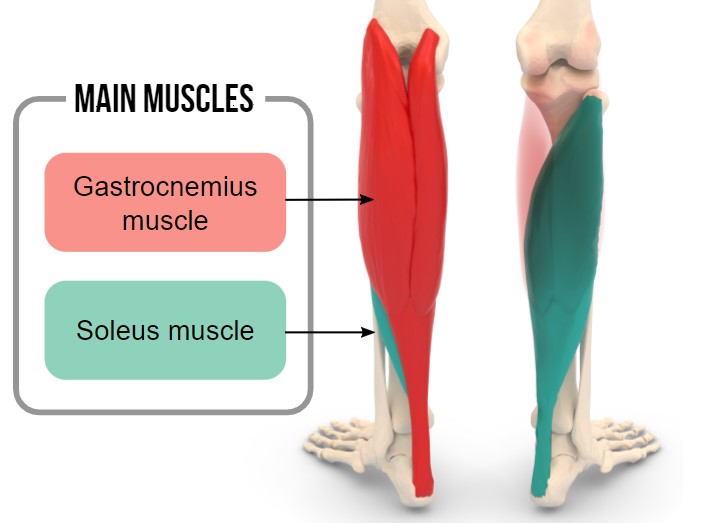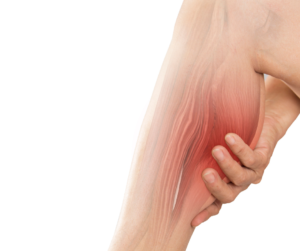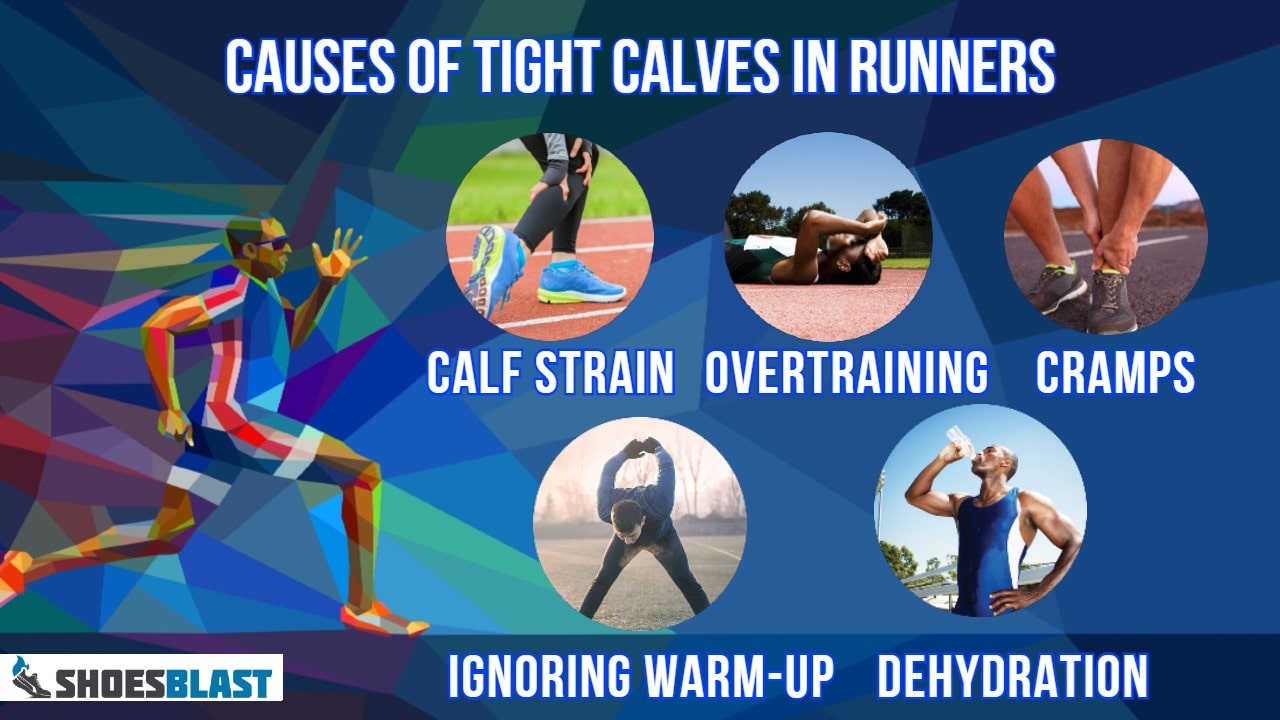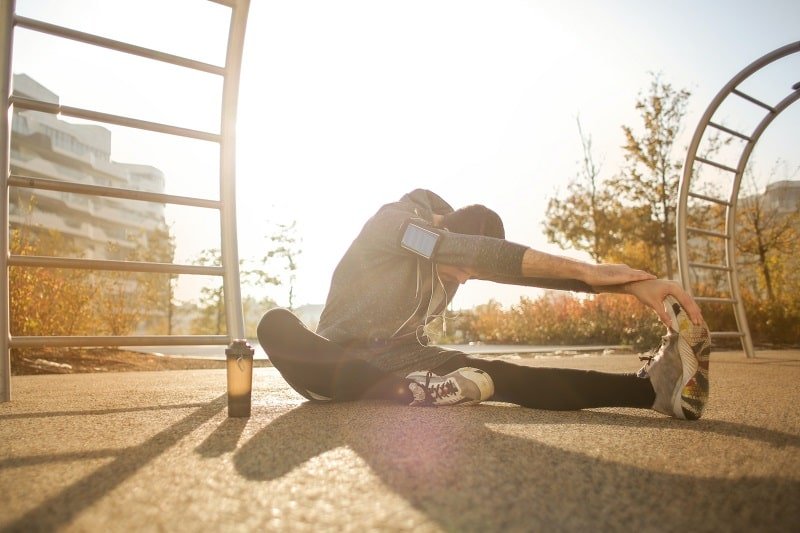Table of Contents
Tight calves are not less than one of the most irritating conditions for runners and proactive sports athletes. Because it never lets the athlete comfortably run with proper foot placement due to limitation in the range of motion and tightness felt in calves at the time of heel strike.
What Should You Know About Calves/Calf Muscles?
As you know, the calves consist of two main muscles: Gastrocnemius and Soleus. They are located at the back of the leg, starting just below the knee and extending up to the ankle.
Their greatest role is founded in running where they assist the foot to bear the stress transferred from ground reaction force while running.
Calves help you walk, jump, and flex your feet too. If you are able to stand on your toes and can look at a celebrity passing through a massive crowd, credit goes to your calves which help you stand up straight on your toes by contracting their muscle fibers.
How Do You Know If Your Calves Are Tight?
So what you’re most likely to be experiencing is probably pain, tightness, or stiffness in the back of the leg just below the knee joint. This can occur either around the knee, around the calf, or around the hamstring. Anything on that posterior aspect can be related to calf tightness.
If you wake up with the feel of these muscles contracted without your control and they do not relax (Charley horses), or if you feel cramps and you have to run around the bedroom for a while to normalize it then you are probably having calf tightness or sooner you are going to have this. This is likely to cause pain.
And of course, if the pain in this area decreases the ability to run or to do any type of athletic or active performance is also a strong sign of tight calves
See other lower leg running injuries.
Symptoms Of Tight Calves
Calves that are tight may feel hard to touch. They may twitch slightly or feel warm because of the inflammation. Sometimes they feel quite painful, especially when under pressure.
Some people experience cramping. Even when the calf does not feel compressed, cramping can cause further pain.
A sort of ‘pulling sensation’ is felt when you try to point or flex your foot. Swelling, bruising, sudden sharp pain, and muscle fatigue in the calves are followed if the tightness is caused by a strain, overuse, or injury. (Gastrocnemius (Calf) Strain)
Seeing a doctor is important if you experience severe pain in the calves that get worse under pressure. This is a sign that there may be a broken bone or serious muscle damage. (Fletcher, 2021)
What Do Tight Calves Indicate?
After assuring that it is the tight calves from which you’re suffering, you must know what’s going on inside your calves or relative areas. What exactly they are indicating to you. That is the time to know the causes which might have led you towards this condition.
1- Calf Strain
Due to running and exercising too vigorously, muscle fibers or tendons may be stretched or torn, causing calf strain. This action occurs when the calf muscles contract and abruptly lengthen, leading to tightness in the calf muscles. If this action is severe, a tear can occur in the calf muscles.
2- Overuse / Overtraining
Athletes who freak out while running or exercising are vulnerable to suffering from tight calves. In addition to adaptation to increased training intensity, your calf muscles need time to recover in order to prevent injury.
If you increase the intensity too quickly or continue to train without allowing them to fully recover, you are at risk of picking up an overuse injury of calf muscles.
3- Cramps
Muscle cramps are sudden and intense pains due to an involuntary contraction of the muscle (Rick Wilkerson, Muscle Cramps, 2017). According to (AAOS), cramps are quite common in the calves.
In running or working out, fatigue is associated with a gradual delay in signaling to your muscles that instruct them to contract and relax.
This delay causes your antagonist and agonist muscles (calves and anterior tibialis) to a contract at the same time, resulting in cramps.
4- Ignoring Warm-Up
If you do not set a warm-up routine properly before your run, or if you do not stretch your calf muscles with consistency before or after running, this can cause muscle tightness in your calves.
Moreover, if you neglect the stretch of your calf muscles on regular basis, your muscles might get shortened and surely become tighter in this way too.
5- Dehydration
As an athlete, You should know that the salt is lost rapidly through sweat during a vigorous workout and so in running. This is another cause of occurring muscle cramps in the lower extremities, especially in calf muscles. That is why it is one of the key causes that lead to tight calves due to cramps
Why Are My Calves Tight While Running?
The way your foot hits the ground when you are running as well as your ankle mobility can also create the possibility of your calves’ tightness.
In the same way, changing your running style too quickly to run on your midfoot or forefoot can also cause problems for your calf muscles (Gruenke, 2022).
It is also possible for the calf muscles to tighten up as a result of any sudden change in your training routine (Louw, 2021). Hilly runs and speedy workouts are two excellent examples of these training sessions. Since both of them require you to run more on your toes, that will increase the strain on the calf muscles.
Is Running Shoe a Problem?
Yes, this can be one of the main reasons for having tight calves while running.
Especially if you wear such sports footwear with elevated heels, your calves become used to getting in shortened form. And they’ll keep that length or near so even after taking the shoes off. As a result, the calf muscles constantly become tighter due to this pressure.
How To Treat Tight Calf Muscles?
I am going to mention here two ways through which relaxation of tight calves will be easier and 100 percent effective without spending a single penny.
- Stretching
- Self Massage
1- Stretching
Stretch Exercise For Calves
- Take a lunge position.
- Bend the front knee and lean forward as far as possible while keeping your back heel flat on the ground.
- Keep your back knee straight (for Gastrocmnecius stretch).
- Keep your back knee bend (for soleus stretch).
- While Gastrocnemius stretch, the stretch will be felt in the upper part of the calves.
- While Soleus stretch, the stretch will be felt in the lower part of the calves.
- Hold each stretch for 30 seconds, and repeat both stretches on the other leg respectively.
Precautions:
Take care of the following three points while performing stretch exercises:
- You should stretch slowly and hold the stretch for between 15 and 30
seconds. - If a stretch causes pain, ease back and continue gently until the muscle
relaxes on its own. If pain continues, stop. - Never stretch with jerks or bounces, this will lead the muscle to the risk of strain or torn.
3- Self-Massage
Self-Massage is the second easiest way to relax your tight calves. It is easy to get into those sore spots by using your fingers or elbows.
If you have a massage ball or foam roller, position this under your calves and gently lean your body weight over it. Hold the pressure on the sorest part of the muscle for a while until the soreness eases off.
Remember That:
- Self-Massaging after a warm shower or after placing a hot pack for a minimum of 10 minutes will enhance the beneficial effect of massage.
- Always aim for a slight soreness during self-massage. This soreness must be within your pain tolerance. Never apply too much pressure or elicit too much pain. This will reverse the aim of the massage.
When to Visit Physical Therapist?
If you suffer from chronic tightness or pain in your calf muscles, consider going to see a physiotherapist who can recommend more specialized stretches and treatments to suit your specific needs.
There is an increased risk of having a more serious condition, such as a deep vein thrombosis (DVT) or tendonitis if your calves are tight but do not ease up after stretching and resting.
Your therapist may recommend you to visit an MD if you experience swelling, inflammation, or worse pain radiations in addition to tight calves.
How Can Runners Overcome Tight Calves
Prevention is always better than cure. If we work according to that here, we need to take some simple measures to prevent tight calves possibilities in near future.
These are the possible steps runner can take to overcome tight calves muscles.
1- Warm-up Before Run
Calf muscles that are warm are less likely to strain or tear. Before doing any physical activity even if it is running itself, be sure to do a warm-up walk or jog to get the blood flow in adequate amount to all calves’ muscle fibers.
2- Stretch After Run
When you are done with running, do not just lie down or drive car for a long duration. This will lead them towards tight tightness. Cool down your muscle from the intensive workout they have performed and stretch your calves as per the above-mentioned exercises.
3- Strengthen Your Calves
What if you have enough strong calves and you do not need to worry about their soreness or tightness or any injury? That’s the best thing that can happen, right? So work on your calves strengthening immediately.
4- Keep Yourself Hydrated
Drinking plenty of water and other mineralized fluids throughout the day decreases the chances of leg cramps, which further become the cause of tight calves.
If you are running on a hot day, try to run early before sunrise for preventing excessive sweating and double heat conduction, via ground and head.
5- Eat a balanced Diet
Eat a well-balanced diet that is rich in calcium, potassium, and magnesium. Add a pre-workout and post-workout diet by the recommendation of your sports physician to replenish any muscular fatigue and cramps.
6- Prioritize Your Shoes
As we have discussed above shoes credit a lot to the health of calf muscles. So get the right running shoes accordingly and eliminate all possible chances of getting tightness in the calves.
How to choose the Right Running Shoes for Tight calves
You need to make sure your running shoes provide enough support for your feet and ankles so that your calves are not put under excessive strain.
The drop of your running shoe is also important to consider. It determines the angle at which your foot is positioned with respect to your calf muscle. The difference in height between the heel and the toe.
It is highly concerned for your prevention because this change in drop angle makes lower drop shoe, which adds strain to your Achilles tendon and calf muscles.
See best running shoes for tight calves. This list has 8 shoes with matching features that a runner requires when running with sore calves.
Is It Okay To Run With Sore Calves/Tight Calves?
Overuse or mild injury can cause tight calves. Continued running or exercise can be okay if there is no limited range of motion, pain, or swelling. But, it is important to note that it can also lead to injury. It is best to rest for a few days or until the pain goes away.
Can dehydration cause tight calf muscles?
Dehydration can cause your calf muscles to feel tight, as well as other symptoms like headaches, dizziness, and tiredness.
When you don’t have enough fluids in your body, your blood volume decreases and your blood pressure drops. This can cause the muscles in your calves to constrict and feel tight. Dehydration can also lead to cramping and spasms in other muscles.
is Tight Calves Common in Runners?
Ummm. Yes you are thinking right. tight calves is a common problem among runners. When runners who do not warm up properly before their runs or do not stretch properly afterward.
You can do several things to prevent or treat tight calves. First, ensure that you warm up before running, and include some calf stretches in your warm-up routine. Second, be sure to stretch your calves after your run. Third, try massaging your calves with a foam roller or tennis ball. And finally, if your calves are still tight, you can try using a calf compression sleeve or wearing compression socks during your runs.
References
- 3 Methods to Fix Tight Calves & Prevent Running Injuries. (2020). Retrieved June 21, 2022, from Core Concepts:
- Calf Muscles. (2021, May 05). Retrieved June 19, 2022, from Cleveleand Clinic:
- Christine Luff, A.-C. (2019, August 15). How to Treat Tight Calf Muscles After Running. Retrieved June 17, 2022, from VeryWellFit:
- Fletcher, J. (2021, February 21). Tight calves: Causes, Treatments, Stretches, and More. Retrieved June 16, 2022, from Medical News Today
- Gastrocnemius (Calf) Strain. (n.d.). Retrieved June 17, 2022, from Sports Medicine Australia:
- Gruenke, J. (2022, January 23). Why Your Calves Are Tight When Running? Retrieved June 22, 2022, from The Balanced Runner
- Louw, M. (2021, March). Struggling with tight calves or calf pain when running. Retrieved June 22, 2022, from Sports Injury Physio:
- Miller KC, Stone MS, Huxel KC, Edwards JE. (2010). Exercise-Associated Muscle Cramps: Causes, Treatment, and Prevention. Sports Health, 83-273.
- Rick Wilkerson, D. (2017, June). Muscle Cramps. Retrieved June 18, 2022, from American Academy of Orthopedic Surgeons:
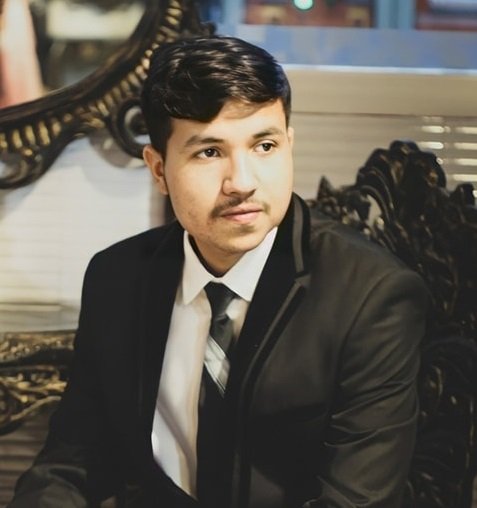
DPT, Jinnah Medical College.
Sports Injuries and Rehabilitation & Sports Nutrition
Martial Arts and Fitness Trainer
Senior Brown Belt – Kyokushinryu Karate, IKAK, Japan.

